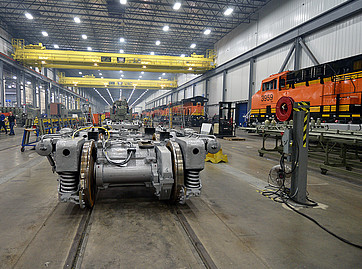2018/10/10 10:00 | Pageview:2525 | From: railwaygazette
The company is looking to build on the experience of GE's aviation business over the past six years to develop additive manufacturing — sometimes referred to as 3D printing — as a means to reduce the time needed to produce components. The resulting components can also be more compact and more precisely designed to meet the end use requirement, Dominique Malenfant, Vice-President of Global Technology, told Railway Gazette at the InnoTrans trade show in Berlin on September 20.
'There is a multitude of different technological options which are covered by the term additive manufacturing', Malenfant explained. One option finding favour for rail component use is binder jetting, which involves a layered application of powder and glue onto a 'build platform' before the completed assembly is 'cooked' in a high-temperature oven. Although the technique is more complex than some additive manufacturing methods, the cost is lower, according to Malenfant.
Additive manufacturing removes the need for castings and time-consuming mould production. Instead, prototyping using rapidly produced moulds can be done in a matter of a couple of days. 'There will be a huge gain in lead times for component design', Malenfant said. 'We could ultimately take months out of the design process.' Another major potential gain is the ability to complete complex components in a single pass. Malenfant gave the example of an engine heat exchanger having 2,000 individual sub-components, joints or welds. All of these potential areas of failure could be eliminated by additive manufacturing, he suggested.

A key aspiration of GE's strategy is to make principal engine components more compact as locomotive technology emerges. GE is seeking to deploy battery-diesel hybrid locomotives to complement the standard 4 000 hp and 4,400 hp locomotives it currently offers, but this 'hybridisation' will require a significant power contribution from the battery and supercapacitor unit. 'If we can shrink the diesel engine through advanced manufacturing, there will be space to increase the batteries we can install onboard', Malenfant explained. This approach underpins the company's objective of enabling battery-only operation of heavy freight trains in urban and other sensitive environmental areas.
GE hopes to begin using 3D printed locomotive parts on a trial basis from next year with a view to widespread adoption by the middle of the next decade.
